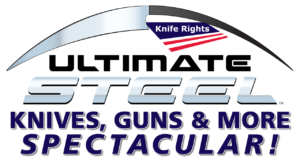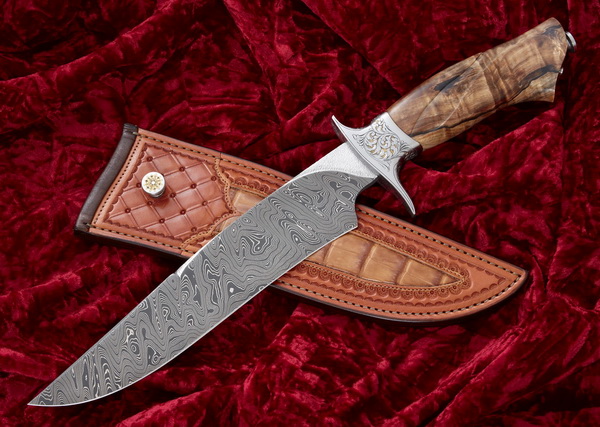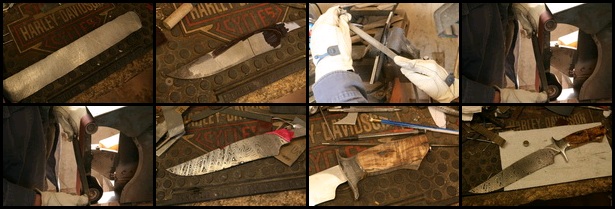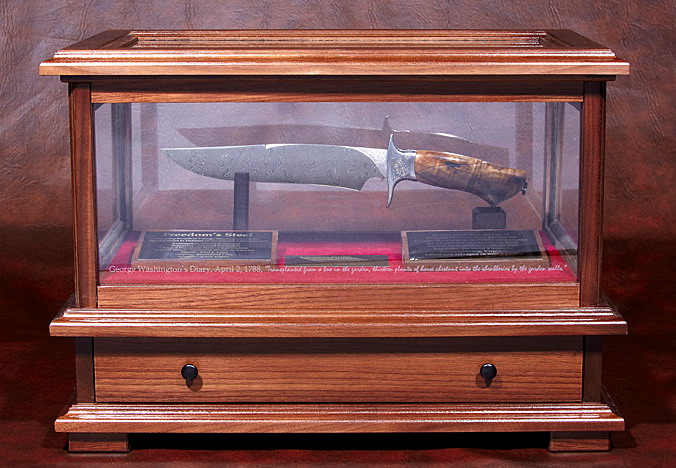Freedom’s Steel™
Knife Rights’ Extraordinary Custom Collaboration Knife
Supporting NRA-ILA and the Second Amendment!
Crafted by Acclaimed Artisans
Incorporating Wood from a Tree Planted by George Washington!
Knife Rights has donated Freedom’s Steel™, an extraordinary custom knife collaboration,to the National Rifle Association’s Institute for Legislative Action (NRA-ILA) in appreciation for their assistance and support of Knife Rights’ legislative efforts in fighting the Second Front in Defense of the Second Amendment™. Freedom’s Steel™ was conceived of, and sponsored by, Knife Rights expressly to benefit NRA-ILA.
Freedom’s Steel™ will be a featured auction item at the NRA-ILA Dinner and Auction to be held at the NRA Annual Meeting in St. Louis, Missouri, the evening of April 13, 2012. Proceeds from the sale of Freedom’s Steel will support NRA-ILA efforts to protect the Second Amendment.
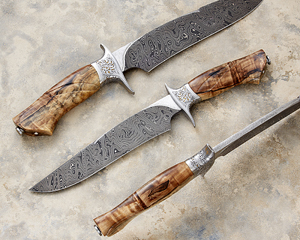 “We are sincerely grateful for the support provided to us by NRA-ILA as we fight the Second Front in Defense of the Second Amendment,” said Knife Rights Chairman and Founder Doug Ritter. “We have a common interest in protecting our civil rights and specifically the right to own and use the tools necessary for self-defense. In an election year when our Second Amendment rights hang in the balance, we are proud to be able to assist NRA in protecting these rights.”
“We are sincerely grateful for the support provided to us by NRA-ILA as we fight the Second Front in Defense of the Second Amendment,” said Knife Rights Chairman and Founder Doug Ritter. “We have a common interest in protecting our civil rights and specifically the right to own and use the tools necessary for self-defense. In an election year when our Second Amendment rights hang in the balance, we are proud to be able to assist NRA in protecting these rights.”
“The NRA has been unapologetic in our fight for freedom and the rights of law-abiding Americans for 141 years. We appreciate the support of our friends at Knife Rights for supporting our efforts during this critical election year,” said Chris W. Cox, Executive Director of the NRA’s Institute for Legislative Action.”
Each craftsman’s efforts and every component of Freedom’s Steel™ was donated to Knife Rights to support its efforts to defend and enhance our right to own and carry knives as tools used daily by millions of Americans and at times wielded in self-defense. This one-of-a-kind 15-inch fighter pattern knife was crafted by prominent knifemaker David Broadwell in his signature “organic style” with historic wood handles from the last of 13 horse chestnut trees planted by George Washington in 1788 to memorialize the 13 colonies and shade the walk between his mother’s cottage and Kenmore, his sister’s home in Fredericksburg, Virginia. This historic tree was felled and salvaged by Historical Woods of America in 2005. The 9-inch blade is 250-layer Wedged Ladder pattern stainless Damascus steel forged by noted Damascus maker Chad Nichols.
The knife has been embellished by renowned master engraver Leonard Francolini and features 24 karat gold inlays and scrollwork.
Custom Leather Maker Paul F. Long hand-crafted the leather, deerskin and alligator sash style sheath which includes a Francolini engraved 24 karat gold inlaid rosette on the stainless frog stud.
Etched into the glass front of the custom built black walnut and glass display case by Brookfield Case is a reproduction of the handwritten diary entry by George Washington dated April 2, 1788, “Transplanted from a box in the garden, thirteen plants of horse chestnut into the shrubberies by the garden walls.”
Photography of Freedom’s Steel™ courtesy of Terrill Hoffman Photography.
About the Knife
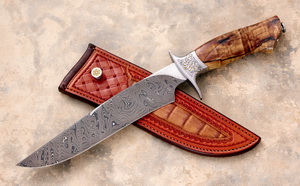 “Freedom’s Steel™” – A Knife Rights Custom Collaboration Knife Honoring NRA’s Institute for Legislative Action and the Second Front in Defense of the Second Amendment™
“Freedom’s Steel™” – A Knife Rights Custom Collaboration Knife Honoring NRA’s Institute for Legislative Action and the Second Front in Defense of the Second Amendment™
Knifemaker: David Broadwell
Engraving: Leonard Francolini
Forged Damascus Steel: Chad Nichols
Handle Wood: Historical Woods of America
Sheath: Paul F. Long
Display Case: Brookfield Case
Photography: Terrill Hoffman
Sponsor: Knife Rights
Recipient: NRA Institute for Legislative Action
(See details of each collaborator below)
Knifemaker David Broadwell has interpreted a fighter pattern knife in his own “organic style” with trademark flowing lines from tip to the engraved finial. He started with Nichols’ quarter-inch thick Damascus billet and freehand ground the blade to shape. Freedom’s Steel™ features a full flat-ground 9-inch blade with a false edge on the spine. After heat treating, the blade was etched and finished to reveal the patterning of the Damascus steel.
The 410 stainless steel guard was likewise, freehand ground and polished before being sent to Francolini for engraving. The finial and the stud for the sheath, both also 410 stainless, were lathe-turned, drilled, tapped (threaded) and polished.
Broadwell hand carved the historic George Washington handle wood into a graceful and ergonomic handhold that seems to call out, “hold me.” The beautiful grain of the horse chestnut wood is emphasized by the flowing lines carved into the sides of the handle. The wood has been stabilized to ensure it will retain its beauty for generations and Broadwell has polished the higher surfaces and left the lower surfaces un-polished to create his signature subtle two-tone effect.
This extraordinary knife handles as well as it looks, balanced as a fighter, just slightly blade heavy. While it is unlikely to ever be used, Freedom’s Steel™ is perfectly serviceable, with a keen edge and heat-treated by Broadwell to hold that edge in use. This is truly functional art.
Blade Length: 9 inches
Blade Thickness: 0.025 inch
Leonard Francolini’s engraving features a 24 karat, flush gold inlaid border surrounding the handle side of the hilt flowing behind the guard and morphing into scrollwork that surrounds 24 karat, flush gold inlaid scrollwork accents on the guard. A 24 karat, flush gold inlaid border surrounds the handle side of the guard. The finial has a 24 karat flush gold inlaid rosette. It is signed “FRANCOLINI” in a recessed, 24 karat gold inlaid rectangle on the bottom of the guard. (click for close-up of engraving.)
The Chad Nichols stainless Damascus steel is comprised of 250 layers of AEB-L and 304 stainless steels carefully folded and refolded into a Wedged Ladder pattern. After grinding and heat treatment by knifemaker Broadwell, the blade was etched to reveal the intricate and beautiful pattern wrought into the Damascus by Nichols. Stainless Damascus steel was chosen to ensure that this treasure will retain its beauty with minimal care, to be cherished by generations to come.
The Historic George Washington Wood Handle
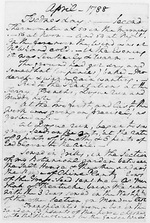 On April 2, 1788, as recorded by George Washington in his handwritten diary, while visiting his mother and sister he “transplanted from a box in the garden, thirteen plants of horse chestnut into the shrubberies by the garden walls” to shade the walk between his mother’s cottage and Kenmore, his sister’s home in Fredericksburg, Virginia. The thirteen trees memorialized the original thirteen colonies.
On April 2, 1788, as recorded by George Washington in his handwritten diary, while visiting his mother and sister he “transplanted from a box in the garden, thirteen plants of horse chestnut into the shrubberies by the garden walls” to shade the walk between his mother’s cottage and Kenmore, his sister’s home in Fredericksburg, Virginia. The thirteen trees memorialized the original thirteen colonies.
By the early 1900s, only five trees survived. Two were blown over in a storm and two died, so that by 1926 only one remained. This last historic tree had been lovingly tended for by the then-current property owner Mrs. John F. Scott, but by then it was clear that if drastic action were not taken, it too would succumb. An appeal was made to Ohio Congressman Martin Davey, President of Davey Tree Expert Service, who responded by sending his experts to examine and treat the historic tree. Over the course of three weeks, they carefully cut out the decayed wood of the tree’s trunk, leaving a cavity large enough for a man to stand in, and Davey was photographed doing just that, inspecting the work of his tree experts. The experts also tended to the tree’s limbs. Then, nearly two tons of concrete was used to seal the cavity and protect the tree.
That served to help prolong the historic horse chestnut’s life for another 83 years until 2005. Battered by disease and storms, at the age of approximately 219 years (according to documented tree ring evidence) the tree had become a safety hazard. Bill Jewell of Historical Woods of America, Inc., was there to supervise the felling and salvage of the historic tree. Over the years the wood from this unique historic George Washington tree has been used for a variety of purposes, including creating fine writing instruments, one-of-a-kind objects and museum quality artwork used for exhibitions, presentations, fundraising and the like.
Sheath
Sheathmaker Paul F. Long handcrafted the sash style sheath to compliment the extraordinary knife and, especially, the color of the historical Horse Chestnut wood handle. The sheath features top grain vegetable tanned, russet colored American cowhide with a light-colored alligator inlay. It is fully lined with supple dark brown deerskin to protect the blade. Long hand-carved and -tooled the embellishments. The stainless frog stud features a Francolini engraved 24 karat gold inlaid rosette. (Click to view the sheath)
Display Case
The black walnut custom display case by Brookfield Case has glass on all four sides and top. Two stanchions hold Freedom’s Steel™ for a presentation worthy of this unique knife. A velvet lined drawer is provided under the knife display to hold the sheath as well as the documentation and provenance for the knife and historical wood used in the handle.
Plaques inside the case are engraved with the name of the knife, all those who donated their talents to craft it and the story of the historic wood used in the handle. Etched into the glass front is a reproduction of the handwritten diary entry by George Washington dated April 2, 1788, “Transplanted from a box in the garden, thirteen plants of horse chestnut into the shrubberies by the garden walls.”
Freedom’s Steel™ will be a featured auction item at the NRA-ILA Dinner and Auction to be held at the NRA Annual Meeting in St. Louis, Missouri, the evening of April 13, 2012. Proceeds from the sale of Freedom’s Steel will support NRA-ILA efforts to protect the Second Amendment. More information on the NRA-ILA Dinner and Auction can be found at: www.nraila.org/ilaauction
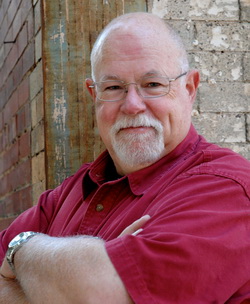 Knifemaker: David Broadwell
Knifemaker: David Broadwell
Broadwell Studios
Wichita Falls, Texas
www.BroadwellStudios.com
Knifemaker David Broadwell has been an artist all of his life. As a child in school he enjoyed all of the art classes he could take, and when he entered middle and high school took both wood shop and mechanical drawing classes. Like many boys he was interested in cars, airplanes and ships, and spent a lot of time drawing them probably at the expense of his other subjects. Today he considers himself an artist still, and expresses his creativity in his knives, pens, and other functional art.
Broadwell’s interest in knives goes back to when he was a young boy. He has fond memories of dressing up in his father’s blue plaid bathrobe, taking up his cardboard shield with the Broadwell coat of arms and strapping on his father’s Masonic dress sword. There were dragons and dark-hearted knights to slay! For several years this interest in edged arms and tools simmered under the surface until in his mid-twenties he felt the urge to create a knife. In 1981, Broadwell took a broken file and made his first knife. With its completion Broadwell knew this was what he wanted to do for a living and he applied himself toward that end. In 1989 Broadwell left his job as a machinist and became a full time knifemaker.
Broadwell’s grinds are complex and must be accomplished freehand. He carved the steel by hand to create his unique style. This maximizes the personal skills and minimizes the machining aspect of his creations. It also gives what has been called “soul” to his work. His knives are one-of-a-kind creations that are highly prized by collectors. He has also had some of his designs turned into production and limited edition knives by Boker and Wilson Combat.
In 2001 Broadwell began creating writing instruments. Many of those childhood drawings were done with fountain pens and he had a strong urge, almost an obsession, to give pens a try. Today Broadwell crafts collectable fountain and roller ball pens using some of the same materials as his knives and with the same passion for creativity.
Broadwell has lived in Wichita Falls, Texas, for most of his life. He is the father of three daughters. Broadwell has been a shooter of firearms since he was a young teenager and has shot pistols competitively in the past.
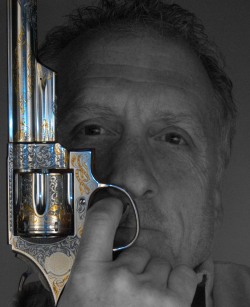 Engraver: Leonard Francolini
Engraver: Leonard Francolini
Leonard Francolini Engraving Corrales, New Mexico
www.francolini.com
Leonard Francolini has been engraving firearms for 40 years, and loves what he does. He started by engraving high speed rotary dies for Preston Engravers in Windsor Locks, Connecticut. These dies were hand engraved to high tolerances and the challenge was strictly one of function – either it worked or it didn’t. There was no art involved, but he learned a lot about steel and how to cut, move and shape it.
In 1972 Francolini was hired by the Engraving Department at the Colt Factory in Hartford, Connecticut. There he learned the art of firearms engraving and gradually developed his own engraving style. The seven years he spent at the Factory gave him invaluable experience in many of the disciplines required to decorate guns – and it was fun. Francolini was exposed to many guns, engraving styles and engraving projects which broadened his perception of the art.
Since 1979 Francolini has been a Freelance Engraver specializing in revolvers and has created some very elaborately engraved guns. A partial list includes:
- The “Four Seasons” Tiffany & Co. designed Smith & Wesson Model 29 for the Royal Armories, London, England.
- Horace Greeley IV’s coffin cased “Vampire Killer” Colt Detective Special featured on the November, 1987 Cover of Guns Magazine. This gun is now on display at the National Firearms Museum.
- A Tiffany & Co. designed Colt Dragoon that used Frederic Remington and George Catlin paintings depicting old west themes. This gun was a birthday gift to Gene Autry from his wife, and is now on display at the Autry National Center in Los Angeles.
- “Tombstone” a Colt Single Action Army revolver depicting the Shootout at the OK Corral in sculpted steel around the non-fluted cylinder.
- “Liberty 100” a Colt Single Action Army revolver embellished with a Statue of Liberty theme and incorporating materials acquired from the Statue. This gun appeared on the July 1986 cover of American Rifleman Magazine.
- “Cowboys and Indians” a pair of Colt Single Action Army revolvers depicting the parallel, but conflicting lives of two groups of people living when the West was still young.
Francolini’s guns have appeared in numerous publications.
- American Engravers and American Engravers – The 21 s t Century by Roger Bleile
- Book of Colt Engraving editions I II and III by R. L. Wilson
- Steel Canvas by R. L. Wilson
- The PostWar Colt Single Action Revolver by Don Wilkerson
- Colt’s SAA Post War Models by George Garton
- American Rifleman Magazine numerous articles including the cover of the July, 1986 issue.
- Guns Magazine numerous articles including the cover of the November, 1987 issue.
- Cowboys and Indians Magazine June, 2009 issue.
His guns have been displayed at the following museums:
- National Firearms Museum in Fairfax, Virginia
- Nevada Museum of Art in Reno, Nevada
- Eiteljorg Museum of American Indians and Western Art in Indianapolis, Indiana
- Stark Museum of Art in Orange, Texas
- Royal Armouries, Tower of London
- Autry National Center in Los Angeles, California
At present Francolini works in his home studio in Corrales, New Mexico and keeps Collectors informed of current projects via his website. There he posts pictures of guns he’s working on as they are being engraved, completed guns, and detailed engraving procedures.
The long list of intended engraving projects continues to get longer rather than shorter so he will always have a gun or two that needs some engraving.
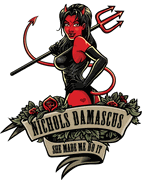 Damascus Steel: Chad Nichols Damascus
Damascus Steel: Chad Nichols Damascus
Chad Nichols
Blue Springs, Mississippi
www.ChadNicholsDamascus.com
Chad Nichols forges premium high carbon, high contrast Damascus, mosaic Damascus and stainless Damascus, as well as Mokume-gane, a Damascus-like laminate forged from copper, brass and nickel silver, and Moku-Ti, a laminate made from pure titanium and a titanium alloy. Chad Nichols Damascus, Mokume and Moku-Ti is used by the world’s best custom knifemakers, as well as for a number of limited-production knives.
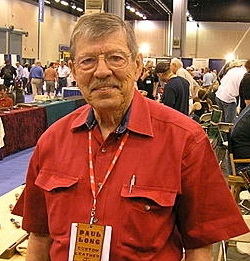 Sheathmaker: Paul F. Long
Sheathmaker: Paul F. Long
West Kerrville, Texas
pfl@cebridge.net
Paul Long started working with leather while attending Texas A&I back in 1951, and it remained a hobby of his until he retired in 1995. After retirement, Paul trained with a master boot and saddle maker for a year. This gave him a good foundation for taking his leather work into almost any direction. In 2004, Paul was asked to make some sheaths for a friend of his who made knives, and the rest is history. Now Paul specializes strictly in knife sheaths, and with nearly 60 years of experience in working with leather, he has become one of the leading sheath makers of our nation.
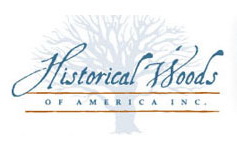 Handle Wood: Historical Woods of America, Inc.
Handle Wood: Historical Woods of America, Inc.
William (Bill) E. Jewell
Woodford, Virginia
www.HistoricalWoods.com
Historical Woods of America’s (HWA’s) goals and services are squarely focused on the reclamation, salvaging and creative repurposing of historical trees and timbers, as well as trees from private, non- historic clients, such as homeowners who have trees to which they have a sentimental connection.
HWA works exclusively with trees or limbs that have fallen in storms, are diseased, unsafe, or are being removed for construction or to maintain the health of the tree — along with timbers removed from historical sites during renovation of existing structures. The wood thus harvested can then be turned into a host of items which have historical connection or sentimental significance.
For owners of historically significant trees, public and private, HWA offers a unique revenue-producing alternative to underutilizing or discarding these rare, limited, valuable resources at a landfill. HWA is committed to preserving not only America’s rich history, but the integrity of the environment through our unique services.
HWA has preserved the historical legacy of many of America’s “witness trees” that grew at the sites of government, national landmarks and historic colonial mansions. Much of this wood has a presidential connection, such as Washington’s Mount Vernon, Jefferson’s Monticello, Madison’s Montpelier, as well as several Civil War sites in Virginia.
HWA also serves the general public in the Mid-Atlantic area who lose trees to storms, trees in decline, or trees to be cleared for building purposes. We can turn salvaged trees and logs into flooring, architectural mill work, siding, furniture, lathe turned art, or working with our artisan associates, almost anything someone can imagine.
 Display Case: Brookfield Case, Inc.
Display Case: Brookfield Case, Inc.
Les Yoder
Coopersville, Michigan
www.BrookfieldCase.com
Brookfield Case is this country’s oldest and largest manufacturer of custom presentation cases. Brookfield Case has built its reputation by serving the collectable firearms and knife industries. The company is proud to specialize in custom wood cases for commemoratives, special editions and unique, one-of-a-kind items and museum pieces.
Brookfield’s cases are the benchmark of quality for the industry. Each case reflects the skill and pride of its craftsmen. From the furniture finish of fine hardwood, to the plush velvet interiors, Brookfield cases provide the perfect showcase for any display or presentation. Brookfield provides custom cases as well as limited production and production cases to many major manufactures, distributors, dealers.
Brookfield Case founder Les Yoder has been in the furniture business as a master craftsman for over 40 years. His experience in early English and French reproductions, high-end executive office furniture and fine clock cabinets is seen in every piece that his highly skilled craftsmen build.
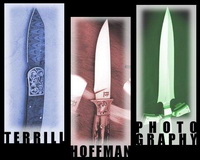 Photography: Terrill Hoffman Photography
Photography: Terrill Hoffman Photography
Terrill Hoffman
Marion, North Carolina
www.terrillhoffman.com
Terrill Hoffman Photography is a privately owned studio dedicated to meeting the photographic needs of the individual knifemakers from around the world. We have been in operation in North Carolina since 1985. While we have elevated our photographic skills over that time, we have done even more. We have learned the desires and problems that face the average knifemaker in building up a business from what most often has started as a hobby. Along with the technical aspects of both businesses, there is also the same problems of advertising and marketing that face the photographer and knifemaker. It is our desire to help by giving knifemakers a photographic record of their knives.
Sponsor: Knife Rights, Inc.
Doug Ritter, Founder and Chairman
www.KnifeRights.org
 Knife Rights was organized in 2006 to ensure a Sharper Future™ for owners of one of mankind’s oldest and most commonly used tools. Elsewhere in the world, many of the knives sold and used daily in the U.S. are illegal or severely restricted and the restrictions are growing every day. Even in the U.S., efforts to demonize knives and to place more restrictions on knives are becoming more commonplace.
Knife Rights was organized in 2006 to ensure a Sharper Future™ for owners of one of mankind’s oldest and most commonly used tools. Elsewhere in the world, many of the knives sold and used daily in the U.S. are illegal or severely restricted and the restrictions are growing every day. Even in the U.S., efforts to demonize knives and to place more restrictions on knives are becoming more commonplace.
Without a dedicated grassroots organization to protect our knives, they are an easy target for those who seek restrictions on our freedoms. Knife Rights was formed to be America’s Grassroots Knife Owners Organization™.
The two pillars upon which Knife Rights stands are “Essential Tools – Essential Rights™.” We cannot retain the former without the latter. While our knives are primarily tools, and used as such the vast majority of the time, ultimately our right to own and carry these tools is enshrined in the Second Amendment for those rare times when they must be used in self-defense. The fight to protect our knives is the Second Front in Defense of the Second Amendment™.
Knife Rights is engaged in promoting legislation that eliminates irrational restrictions on knife possession and opposing anti-knife legislation, as well as the legal defense of knife owner civil rights.
Recipient: National Rifle Association’s Institute for Legislative Action (NRA-ILA)
www.nraila.org
 The Institute for Legislative Action (ILA) is the lobbying arm of the NRA. Established in 1975, ILA is committed to preserving the right of all law-abiding individuals to purchase, possess and use firearms for legitimate purposes as guaranteed by the Second Amendment to the U.S. Constitution. While NRA is a single-issue organization, ILA is involved in any issue that directly or indirectly affects firearms ownership and use. ILA is also involved in educating the public about the facts concerning the many facets of firearms ownership in America.
The Institute for Legislative Action (ILA) is the lobbying arm of the NRA. Established in 1975, ILA is committed to preserving the right of all law-abiding individuals to purchase, possess and use firearms for legitimate purposes as guaranteed by the Second Amendment to the U.S. Constitution. While NRA is a single-issue organization, ILA is involved in any issue that directly or indirectly affects firearms ownership and use. ILA is also involved in educating the public about the facts concerning the many facets of firearms ownership in America.


